Recent Posts
Understand the Terminology of the Industry
2/14/2024 (Permalink)
SERVPRO of Lee's Summit is always "Here to Help". We know the jargon can be confusing so we usually try to break it down as easy as we can out in the field, however we know this can be complicating to our customers and their ability to stay informed. Here are some common terms used in the field with their definition so you can a clearer understanding of what is happening in your home or business.
Anti-Microbials: A substance, mechanism, or condition that inhibits the growth or existence of an organism.Commonly applied after a water damage to prevent mold from developing.
Fire Damage Recovery: The process of restoring and recovering property and belongings after a fire. The objectives include minimizing existing damage, damage mitigation, structure stabilization, soot & odor removal and reconstruction.
Fungi: The unicellular or multicellular eukaryotic/ DNA organisms embracing a large group of microflora including: molds, mildews, yeasts, mushrooms, rusts and smuts.
HVAC: Heating, ventilation and air conditioning.
HEPA Filter: High efficiency particulate air filter, a specialized filter capable of removing 99.7% of particles. Commonly used in mold or odor job sites. HEPA Vacuum or HEPA air scrubber.
Masking Agents: Designed to prevent or remove heightened awareness to odors by providing a fragrance, which is stronger and more pleasant to smell while the source of the odor is being eliminated.
Smoke Damage Removal: Neutralizing or removing smoke odors that linger after fires.
Smoke Particles: Smoke is composed of gases / sometimes aerosols, and airborne solids. Dry wood, natural fibers and paper all produce small non-smearing material. Plastic, foam, and rubber (polymers) produce large easily smeared residues.
Mitigation: Mitigation refers to actions or strategies taken to reduce or lessen the severity of negative impacts or consequences, such as those associated with natural disasters, climate change, or technological failures. The goal of mitigation is to prevent or reduce harm and to prepare for future events.
These terms while complicate incompass the entiretly of the job being performed to bring your property back up to preloss conditions. We try to inform our clients the best that we can to eliminate any confusions and provide you with the necessary information to make informed decisions about your property.
Can My Items Be Cleaned After Exposure to Mold?
2/14/2024 (Permalink)
Mold can be invasive, however when treated right certain items can be saved after exposure to mold. Some specific items that can be saved from mold with the right treatment include:
Books, papers, and documents: Mold can cause discoloration and disintegration of paper items, but if treated promptly, they can often be cleaned and restored.
Furniture: Wooden furniture, especially antiques, can be particularly susceptible to mold damage, but with proper cleaning, they can often be restored to their original condition.
Clothing and textiles: Mold can cause musty odors, staining, and deterioration of fabrics, but with the right treatment, they can often be cleaned and deodorized.
Electronics: Mold can cause corrosion of electronic components and cause short circuits, but with proper cleaning, many electronic items can be restored to working condition.
It's important to note that not all items can be saved from mold, and in some cases, it may be more cost-effective to simply replace the item. It's important to take proper safety precautions when handling mold-contaminated items, as mold can pose health hazards if not handled correctly.
With this being said, if you are experiencing a mold situation in your property, give us a call today to have the experts evaluate the items that are at risk and remediate the situation.
Leading Experts for Training & Industry Standards
2/14/2024 (Permalink)
If you get sick, you go to a trained medical professional to back to optimal health. If something happens to your home or business, don’t leave restoration up to chance. Count on trusted, certified restoration experts to handle any property damage, from flooding to mold to fire. Finding the right help means finding the right company with the industry standards and certifications for a given industry, Institute of Inspection Cleaning and Restoration Certification standards.
What Is IICRC?
For nearly 40 decades, this nonprofit has globally become an industry leader for setting standards and certifying technicians. To achieve a mitigation certificate, technicians take specialized classes on standards and techniques and are required to pass an exam. Afterward, they maintain certification through ongoing training.
These areas of certification include:
Cleaning – Subspecialties include carpeting, flooring, leather cleaning, masonry, upholstery, rugs, and general cleaning.
Inspection – Technicians are trained to inspect all types of flooring, including wood, marble, laminate, tiles, carpet, and stone.
Restoration – This training focuses on techniques for microbial remediation, structural drying, fire and smoke damage, odor, water damage, commercial drying, and health and safety.
Why Training Matters
The lingering effects of water, smoke and fire damage can cause further problems and create unpleasant environments. When a storm happens or a fire breaks out, you want it handled quickly and efficiently. SERVPRO® prides itself on having IICRC certified professionals, as well as providing its own training to ensure every franchise has experts to handle any disaster. Along with learning the best techniques and standard procedures within the industry, they are also trained on using innovative equipment to ensure that mold, smoke, water, or other damage is eradicated. Our ongoing franchise training means that no matter what you are facing, we can make it “Like it never even happened.”
While some situations may seem like they can be taken care of on their own, some damage to a property can remain hidden within the structural components that can only be detected with specialized tools and industry knowledge. Instead of hoping for the best, ensure your property is back into pristine condition with hiring a qualified restoration and remediation specialist backed by the IICRC.
Understanding our Terms and Lingo
2/8/2023 (Permalink)
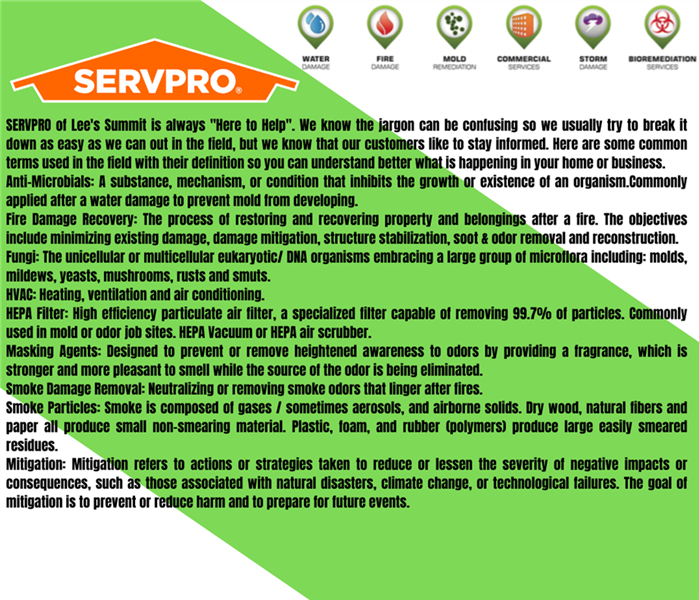 Understanding our Terms and Lingo
Understanding our Terms and Lingo
SERVPRO of Lee's Summit is always "Here to Help". We know the jargon can be confusing so we usually try to break it down as easy as we can out in the field, but we know that our customers like to stay informed. Here are some common terms used in the field with their definition so you can understand better what is happening in your home or business.
Anti-Microbials: A substance, mechanism, or condition that inhibits the growth or existence of an organism.Commonly applied after a water damage to prevent mold from developing.
Fire Damage Recovery: The process of restoring and recovering property and belongings after a fire. The objectives include minimizing existing damage, damage mitigation, structure stabilization, soot & odor removal and reconstruction.
Fungi: The unicellular or multicellular eukaryotic/ DNA organisms embracing a large group of microflora including: molds, mildews, yeasts, mushrooms, rusts and smuts.
HVAC: Heating, ventilation and air conditioning.
HEPA Filter: High efficiency particulate air filter, a specialized filter capable of removing 99.7% of particles. Commonly used in mold or odor job sites. HEPA Vacuum or HEPA air scrubber.
Masking Agents: Designed to prevent or remove heightened awareness to odors by providing a fragrance, which is stronger and more pleasant to smell while the source of the odor is being eliminated.
Smoke Damage Removal: Neutralizing or removing smoke odors that linger after fires.
Smoke Particles: Smoke is composed of gases / sometimes aerosols, and airborne solids. Dry wood, natural fibers and paper all produce small non-smearing material. Plastic, foam, and rubber (polymers) produce large easily smeared residues.
Mitigation: Mitigation refers to actions or strategies taken to reduce or lessen the severity of negative impacts or consequences, such as those associated with natural disasters, climate change, or technological failures. The goal of mitigation is to prevent or reduce harm and to prepare for future events.
Specific Items You can save from mold
2/8/2023 (Permalink)
 These shoes were saved from a water loss in Kansas City.
These shoes were saved from a water loss in Kansas City.
Some specific items that can be saved from mold with the right treatment include:
Books, papers, and documents: Mold can cause discoloration and disintegration of paper items, but if treated promptly, they can often be cleaned and restored.
Furniture: Wooden furniture, especially antiques, can be particularly susceptible to mold damage, but with proper cleaning, they can often be restored to their original condition.
Clothing and textiles: Mold can cause musty odors, staining, and deterioration of fabrics, but with the right treatment, they can often be cleaned and deodorized.
Electronics: Mold can cause corrosion of electronic components and cause short circuits, but with proper cleaning, many electronic items can be restored to working condition.
It's important to note that not all items can be saved from mold, and in some cases, it may be more cost-effective to simply replace the item. Also, it's important to take proper safety precautions when handling mold-contaminated items, as mold can pose health hazards if not handled properly.
Understanding Property Damage Insurance
2/8/2023 (Permalink)
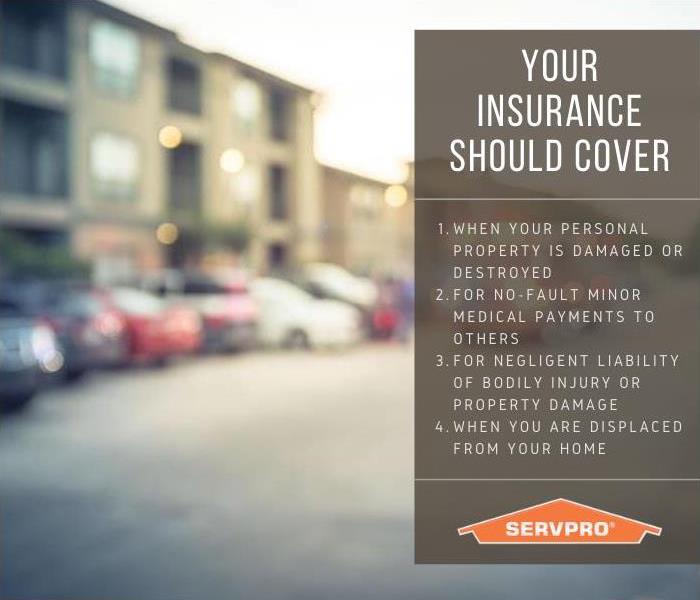 What your insurance should cover.
What your insurance should cover.
Property damage insurance is a type of insurance coverage that protects homeowners and business owners against loss or damage to their property and contents due to various covered events, such as fire, theft, natural disasters, and other specified perils.
The key elements of property damage insurance include:
Coverage limits: This is the maximum amount of money the insurance company will pay for covered losses. Coverage limits vary depending on the policy and the type of coverage purchased.
Deductibles: This is the amount of money the policyholder must pay out of pocket before the insurance coverage kicks in. Deductibles are typically expressed as a dollar amount or a percentage of the coverage limit.
Covered events: This is the list of perils or events that are covered under the policy. The types of events covered can vary depending on the policy and the type of coverage purchased.
Exclusions: This is a list of events or situations that are not covered under the policy. Exclusions can include things like war, nuclear events, intentional acts, and others.
Claims process: This is the process for reporting a covered loss and filing a claim with the insurance company. The claims process typically involves providing documentation, meeting with an adjuster, and following other requirements set forth by the insurance company.
It's important to carefully review the terms and conditions of a property damage insurance policy and to understand the coverage limits, deductibles, and other elements before purchasing coverage. This can help ensure that policyholders are fully protected in the event of a loss and can make the claims process smoother and more straightforward.
Love What's Local
2/8/2023 (Permalink)
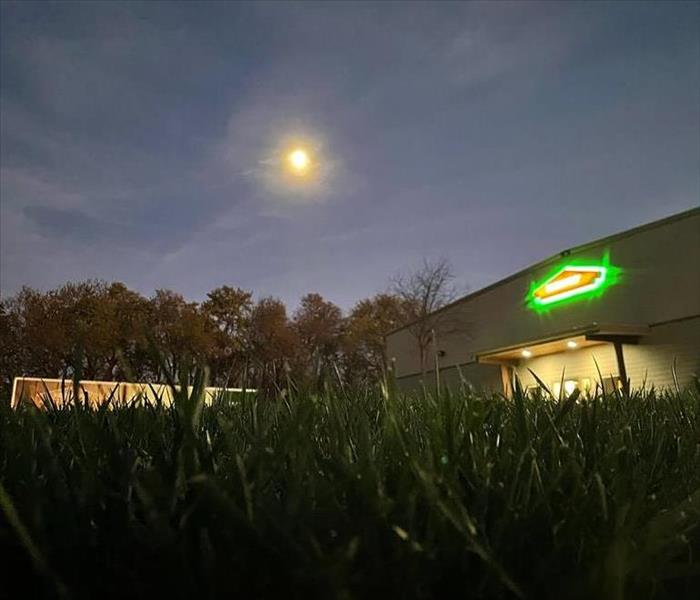 Love your local SERVPRO
Love your local SERVPRO
When a disaster occurs, working with a company that is local to the area can be useful for a variety of reasons. However, a small local company may only specialize in certain types of disaster responses, and also may not be able to tackle large restoration projects. Regardless of how much or what type of damage has occurred, a local restoration franchise that has been certified can appropriately respond to a disaster of any kind.
Supporting local businesses is important for many reasons. It can strengthen the local economy, provide jobs and contribute to the unique character of a community. Restoration companies like SERVPRO offer important services to help communities recover from disaster, and choosing a local provider can also ensure quick response times and personalized attention to your needs.
Though a corporation may have the experience necessary to respond to major damage, a company that isn’t locally owned may not understand the unique challenges that come with local landscapes. Additionally, a company that isn’t local is likely to have a slower response time, which can ultimately result in a building sustaining additional damage. However, a SERVPRO franchise that is local to a business owner’s area can mitigate the damage by responding quickly.
Often, a local franchise has a myriad of tools that other restoration companies may not have. We have partners that can quickly send the needed tools to the franchise. Additionally, your local SERVPRO is more likely to have spent time studying procedures and practices, meaning that professionals from a local franchise will have up-to-date information on how to best handle any situation.
After a disaster or contamination of any kind, it is often helpful to employ a local restoration franchise. A SERVPRO franchise can manage problems of any size, respond quickly after disasters, and can provide the necessary tools and equipment needed for restoration. Call your local SERVPRO today!
Gain trust with your local certified restoration company
2/8/2023 (Permalink)
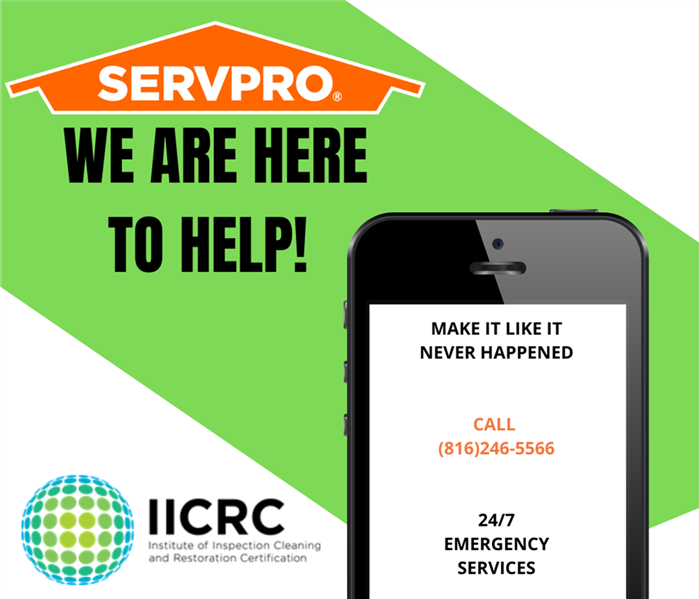 Call SERVPRO of Lee's Summit for all your mitigation needs.
Call SERVPRO of Lee's Summit for all your mitigation needs.
If you get sick, you go to a trained medical professional to back to optimal health. If something happens to your home or business, don’t leave restoration up to chance. Count on trusted, certified restoration experts to handle any property damage, from flooding to mold to fire. Finding the right help means finding the right help that adheres to the Institute of Inspection Cleaning and Restoration Certification standards.
What Is IICRC?
For nearly 40 decades, this nonprofit has globally become an industry leader for setting standards and certifying technicians. To achieve a mitigation certificate, technicians take specialized classes on standards and techniques and are required to pass an exam. Afterward, they maintain certification through ongoing training. Areas of certification include:
Cleaning – Subspecialties include carpeting, flooring, leather cleaning, masonry, upholstery, rugs, and general cleaning.
Inspection – Technicians are trained to inspect all types of flooring, including wood, marble, laminate, tiles, carpet, and stone.
Restoration – This training focuses on techniques for microbial remediation, structural drying, fire and smoke damage, odor, water damage, commercial drying, and health and safety.
Why Training Matters
The lingering effects of water, smoke and fire damage can cause further problems and create unpleasant environments. When a storm happens or a fire breaks out, you want to fix it and forget it. SERVPRO prides itself on having IICRC certified professionals, as well as provides its own training to ensure every franchise has experts to handle any disaster. Along with learning the best techniques, they are also trained on using innovative equipment to ensure that mold, smoke, water, or other damage is eradicated. Our ongoing franchise training means that no matter what you are facing, we can make it “Like it never even happened.”
While some situations may seem like they can be taken care of on their own, some damage to a property can remain hidden. Instead of hoping for the best, get the best to get your property back into pristine condition without any worry.
ERP's and why they are important
2/8/2023 (Permalink)
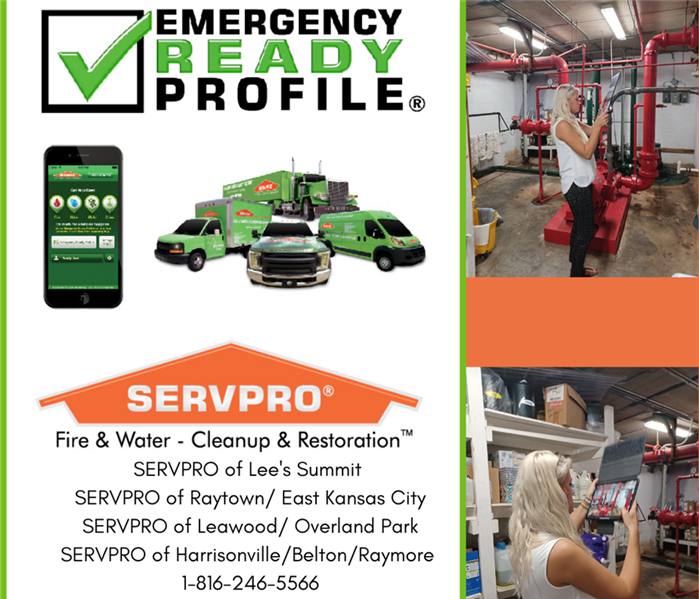 Call us today to prepare an ERP for your business.
Call us today to prepare an ERP for your business.
Being a business owner can have many responsibilities, and you may have to take on multiple roles.
In most cases, disaster is the last thing you are thinking about, but every business owner, regardless of how new or old your business is, should have a plan and guide for what to do in the event of a disaster.
SERVPRO offers a free community service called the "Emergency Ready Plan", or an ERP.
ERP's are handy little guides that we make at SERVPRO that contain basic information regarding your property, who owns the property, and where your emergency shut off locations are.
We document and photograph where your electrical, water, and gas shut offs are, as well as your sprinkler system and security system. We also have the contacts for those utilities companies in the event that you must make contact.
Key contacts are also listed in the ERP, such as the owner, the insurance agent for the property, the SERVPRO representative, and the managers of the building.
The emergency contacts and services page has the fire department and police department's emergency and non-emergency numbers as well, that way, if contact is needed, you know where to find all those phone numbers and contact points.
It's very beneficial to have an ERP because although the business owner might know where everything is and who to contact, your employees might not know. Having a guide like this can help so much if the business owner is not present.
ERP's are very convenient as well, we are able to provide a paper copy, and we can provide a digital version on the Ready Plan app! Which makes ERP's very easy to access in times of need.
When you run a business, it's good to prepare for not just the next day's shift, but for the things that happen unexpectedly.
SERVPRO is always here to help!
5 Tips to Protect Your Home From Water Damage
2/8/2023 (Permalink)
 Read these tips to protect your home!
Read these tips to protect your home!
Whether you have a leaking water heater or live in a location that experiences frequent storms, protecting your Long View, MO, home from water damage can be a concern for any homeowner. Fortunately, there are a number of things you can do that may help mitigate your risk.
1. Stay Aware of the Weather
It’s important to be aware of the weather in your area. Knowing ahead of time when a storm will arrive and how severe it could be may allow you to take steps ahead of time to alleviate the damage. You may want to cover at-risk areas with a tarp and ensure all windows are closed.
2. Adjust Your Landscaping
Another tip to consider is to use your landscaping to help direct water flow away from your home. Sloping your yard slightly, including drainage areas, or planting deep-rooted shrubs may all help reduce the risk of storm flooding around your home.
3. Regularly Inspect for Damage
Inspecting your home for leaks on a regular basis is essential. This may help you discover that leaking water heater or missing roof shingle before long-term damage can set in. If you do find an issue such as a broken water heater, it’s essential to begin repairs promptly.
4. Fix Leaks Quickly
If you observe a leak from a failed water heater, flooded roof gutter, cracked window, or frozen pipe, it’s crucial to contact a local water damage restoration service immediately. The sooner a leak is fixed, the less damage the water can cause.
5. Install Proper Drainage
One of the main steps you can take to protect your home is to install drainage. This may include gutters and downspouts leading away from the exterior of the home, sump pumps, or basement area.
Remember - if you have issues such as a leaking water heater, it’s critical to contact a professional and have repairs made as soon as possible. You may also want to consider steps such as regular inspections for damage and the installation of proper drainage to further protect your home.





 24/7 Emergency Service
24/7 Emergency Service






